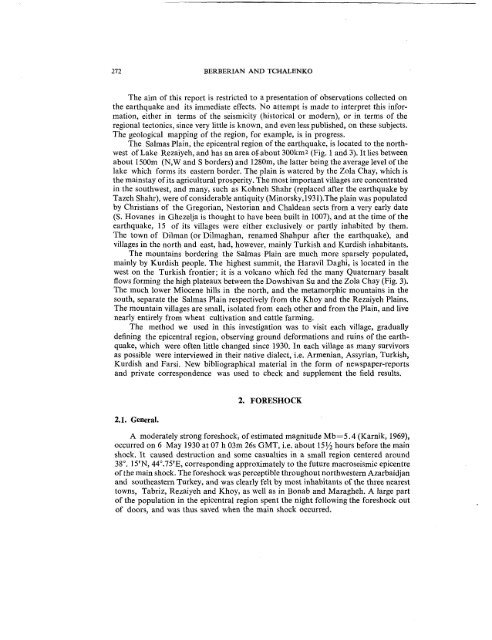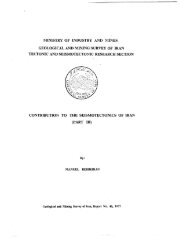Create successful ePaper yourself
Turn your PDF publications into a flip-book with our unique Google optimized e-Paper software.
272 BERBERIAN AND TCHALENKOThe aim of this report is restricted to a presentation of observations collected onthe earthquake and its immediate effects. No attempt is made to interpret this information,either in terms of the seismicity (historical or modern), or in terms of theregional tectonics, since very little is known, and even less published, On these subjects.The geological mapping of the region, for example, is in progress.The Salmas Plain, the epicentral region of the earthquake, is located to the northwestof Lake Rezaiyeh, and has an area of-about 300kin2 (Fig. 1 and 3). It lies betweenabout 1500m (N,W and S borders) and 1280m, the latter being the average level of thelake which forms its eastern border. The plain is watered by the Zola Chay, which isthe mainstay of its agricultural prosperity. The most important villages are concentratedin the southwest, and many, such as Kohneh Shahr (replaced after the earthquake byTazeh Shahr), were of considerable antiquity (Minorsky,1931).The plain was populatedby Christians of the Gregorian, Nestorian and Chaldean sects from a very early date(S. Hovanes in Ghezelja is thought to have been built in 1007), and at the time of theearthquake, 15 of its villages were either exclusively or partly inhabited by them.The town of Dilman (or Dilmaghan, renamed Shahpur after the earthquake), andvillages in the north and east, had, however, mainly Turkish and Kurdish inhabitants.The mountains bordering the Salmas Plain are much more sparsely populated,mainly by Kurdish people. The highest summit, the Haravil Daghi, is located in thewest on the Turkish frontier; it is a volcano which fed the many Quaternary basaltflows forming the high plateaux between the Dowshivan Su and the Zola Chay (Fig. 3).The much lower Miocene hills in the north, and the metamorphic mountains in thesouth, separate the Salmas Plain respectively from the Khoy and the Rezaiyeh Plains.The mountain villages are small, isolated from each other and from the Plain, and livenearly entirely from wheat cultivation and cattle farming.The method we used in this investigation was to visit each village, graduallydefining the epicentral region, observing ground deformations and ruins of the earthquake,which were often little changed since 1930. In each village as many survivorsas possible were interviewed in their native dialect, i.e. Armenian, Assyrian, Turkish,Kurdish and Farsi. New bibliographical material in the form of newspaper-reportsand private correspondence was used to check and supplement the field results.2.1. General.2. FORESHOCKA moderately strong foreshock, of estimated magnitude Mb---- 5.4 (Karnik, 1969),occurred on 6 May 1930 at 07 h 03m 26s GMT, i.e. about 15½ hours before the mainshock. It caused destruction and some casualties in a small region centered around38 °. 15’N, 44°.75’E, corresponding approximately to the future macroseismic epicentreof the main shock. The foreshock was perceptibl e throughout northwestern Azarbaidjanand southeastern Turkey, and was clearly felt by most inhabitants of the three nearesttowns, Tabriz, Rezaiyeh and Khoy, as well as in Bonab and Maragheh. A large partof the population in the epicentral region spent the night following the foreshock outof doors, and was thus saved when the main shock occurred.







